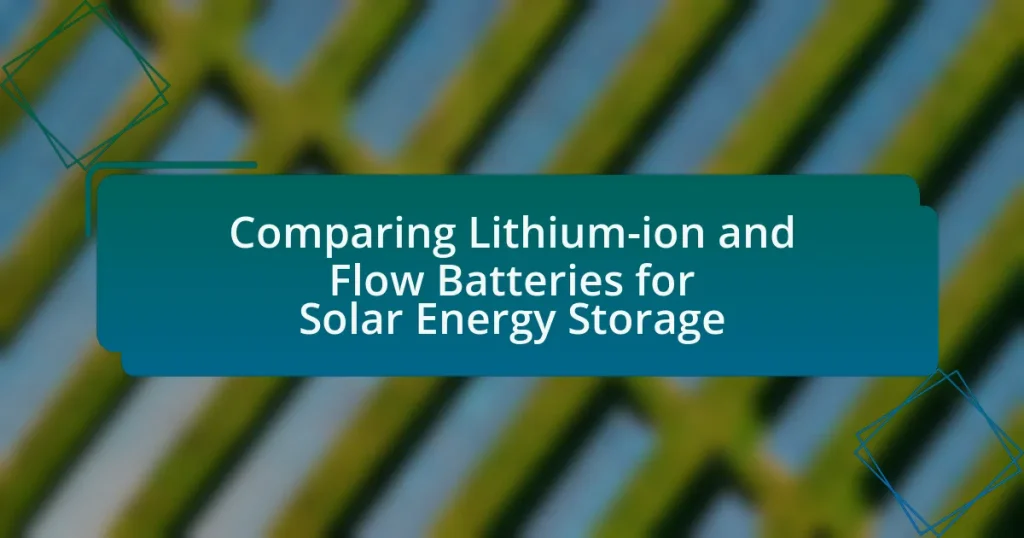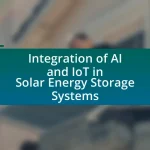Lithium-ion and flow batteries are two prominent technologies used for solar energy storage, each with distinct characteristics and applications. Lithium-ion batteries are known for their high energy density, efficiency, and compact size, making them suitable for residential and commercial solar systems. In contrast, flow batteries utilize liquid electrolytes for scalable energy storage, offering longer discharge times and enhanced safety, which are advantageous for large-scale applications. This article compares the operational mechanisms, key components, advantages, and practical applications of both battery types, highlighting their respective roles in optimizing solar energy storage solutions. Additionally, it examines cost implications and best practices for selecting the appropriate battery technology based on specific project requirements.
What are Lithium-ion and Flow Batteries?
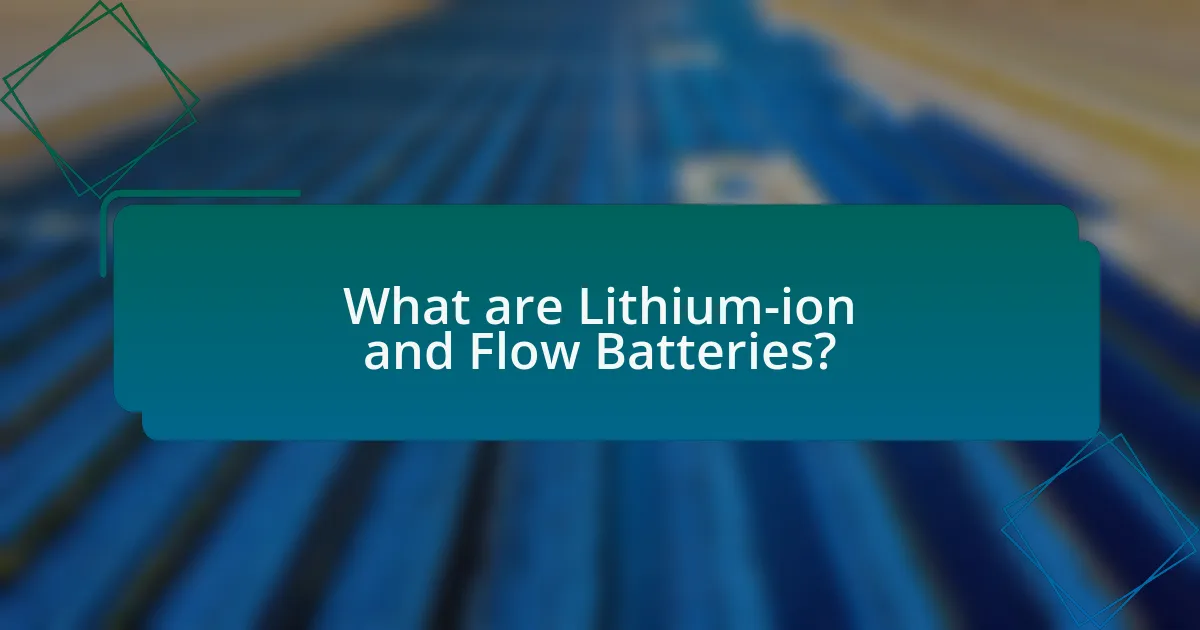

Lithium-ion batteries are rechargeable energy storage devices that utilize lithium ions to move between the anode and cathode during charging and discharging. They are widely used in consumer electronics, electric vehicles, and renewable energy applications due to their high energy density, efficiency, and relatively low self-discharge rates. Flow batteries, on the other hand, are a type of rechargeable battery where energy is stored in liquid electrolytes contained in external tanks, allowing for scalable energy storage and longer discharge times. Flow batteries are particularly advantageous for large-scale energy storage applications, such as solar energy systems, due to their ability to decouple power and energy capacity, enabling longer operational lifetimes and easier maintenance.
How do Lithium-ion batteries function in energy storage?
Lithium-ion batteries function in energy storage by utilizing electrochemical reactions to store and release electrical energy. During charging, lithium ions move from the positive electrode (cathode) to the negative electrode (anode) through an electrolyte, while electrons flow through an external circuit, creating a current. When discharging, the process reverses; lithium ions travel back to the cathode, releasing energy that can be used to power devices. This mechanism allows for high energy density and efficiency, making lithium-ion batteries a preferred choice for applications such as solar energy storage, where they can efficiently store excess energy generated during peak sunlight hours for later use.
What are the key components of Lithium-ion batteries?
The key components of Lithium-ion batteries are the anode, cathode, electrolyte, and separator. The anode is typically made of graphite, while the cathode is often composed of lithium metal oxides such as lithium cobalt oxide or lithium iron phosphate. The electrolyte, which facilitates the movement of lithium ions between the anode and cathode, is usually a lithium salt dissolved in an organic solvent. The separator is a porous membrane that prevents direct contact between the anode and cathode while allowing ionic transport. These components work together to enable the efficient storage and release of electrical energy, making Lithium-ion batteries a popular choice for applications like solar energy storage.
What advantages do Lithium-ion batteries offer for solar energy storage?
Lithium-ion batteries provide several advantages for solar energy storage, including high energy density, efficiency, and longevity. Their high energy density allows for more energy storage in a smaller physical space, making them ideal for residential and commercial solar systems. Additionally, lithium-ion batteries typically have a round-trip efficiency of around 90-95%, meaning that a significant portion of the stored energy can be effectively used. Furthermore, these batteries have a longer lifespan, often exceeding 10 years, which reduces the frequency and cost of replacements compared to other battery technologies.
How do Flow batteries operate in energy storage systems?
Flow batteries operate in energy storage systems by utilizing two electrolyte solutions that are stored in separate tanks and circulated through a cell stack where electrochemical reactions occur. During charging, electrical energy is converted into chemical energy, causing ions to move between the two solutions through a membrane, while during discharging, the reverse process occurs, releasing energy for use. This mechanism allows flow batteries to provide scalable energy storage, as the energy capacity can be increased by simply enlarging the size of the electrolyte tanks, making them suitable for large-scale applications such as solar energy storage.
What are the main components of Flow batteries?
The main components of flow batteries are the electrolyte, the electrodes, and the membrane. The electrolyte, which is typically a liquid solution containing dissolved active materials, facilitates the electrochemical reactions that store and release energy. The electrodes, usually made of conductive materials, serve as the sites for these reactions, allowing electrons to flow during charging and discharging. The membrane, often a selective ion exchange membrane, separates the two electrolyte solutions while allowing ions to pass through, maintaining the flow of charge and preventing mixing of the electrolytes. These components work together to enable the unique operation of flow batteries, distinguishing them from other battery types.
What are the benefits of using Flow batteries for solar energy storage?
Flow batteries offer several benefits for solar energy storage, including scalability, long cycle life, and enhanced safety. Their modular design allows for easy scaling to meet varying energy storage needs, making them suitable for both small and large solar installations. Flow batteries can endure thousands of charge and discharge cycles without significant degradation, often exceeding 10,000 cycles, which results in lower replacement costs over time. Additionally, flow batteries utilize non-flammable electrolytes, reducing fire hazards compared to conventional lithium-ion batteries, thus enhancing overall safety in energy storage applications.
What are the key differences between Lithium-ion and Flow Batteries?
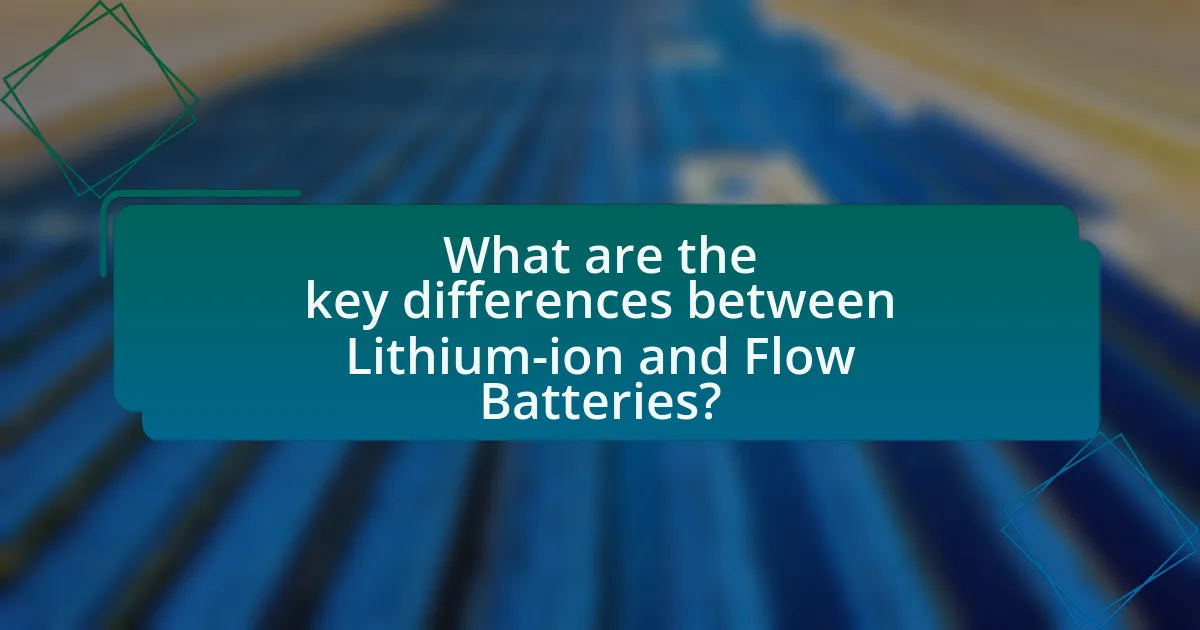

Lithium-ion batteries and flow batteries differ primarily in their energy storage mechanisms and applications. Lithium-ion batteries store energy chemically within solid electrodes, allowing for high energy density and compact size, making them suitable for portable electronics and electric vehicles. In contrast, flow batteries store energy in liquid electrolytes contained in external tanks, enabling scalability and longer discharge times, which are advantageous for large-scale energy storage applications like renewable energy integration.
Lithium-ion batteries typically have a higher energy density, around 150-250 Wh/kg, while flow batteries generally have lower energy density, approximately 20-40 Wh/kg. However, flow batteries can be cycled more frequently without significant degradation, offering longer lifespans, often exceeding 10,000 cycles compared to 2,000-5,000 cycles for lithium-ion batteries. Additionally, flow batteries can be easily scaled by increasing the size of the electrolyte tanks, whereas lithium-ion systems require more complex arrangements for larger capacities.
These differences highlight the suitability of lithium-ion batteries for applications requiring compactness and high energy output, while flow batteries are better suited for applications needing long-duration energy storage and scalability.
How do the energy densities of Lithium-ion and Flow batteries compare?
Lithium-ion batteries have a significantly higher energy density compared to flow batteries, typically ranging from 150 to 250 Wh/kg for lithium-ion, while flow batteries generally range from 20 to 40 Wh/kg. This difference in energy density means that lithium-ion batteries can store more energy in a smaller and lighter package, making them more suitable for applications where space and weight are critical factors. In contrast, flow batteries, while having lower energy density, offer advantages in scalability and longer cycle life, which can be beneficial for large-scale energy storage solutions.
What impact does energy density have on solar energy storage?
Energy density significantly impacts solar energy storage by determining how much energy can be stored in a given volume or mass of the storage medium. Higher energy density allows for more energy to be stored in a smaller and lighter system, which is crucial for optimizing space and reducing costs in solar energy applications. For instance, lithium-ion batteries typically have an energy density of around 150-250 Wh/kg, making them suitable for residential and commercial solar storage. In contrast, flow batteries, which have lower energy densities (approximately 20-40 Wh/kg), require larger installations to store equivalent amounts of energy, potentially increasing space and infrastructure costs. Thus, the choice of storage technology based on energy density directly influences the efficiency, scalability, and economic viability of solar energy systems.
How do Lithium-ion and Flow batteries differ in terms of cycle life?
Lithium-ion batteries typically have a cycle life of 500 to 2,000 cycles, while flow batteries can achieve a cycle life of 2,000 to over 10,000 cycles. This significant difference arises from the design and chemistry of the batteries; lithium-ion batteries degrade over time due to electrode wear and electrolyte decomposition, whereas flow batteries utilize liquid electrolytes that can be replenished, allowing for longer operational lifespans. Studies indicate that the longevity of flow batteries makes them particularly suitable for applications requiring frequent cycling, such as solar energy storage systems.
What are the cost implications of using Lithium-ion versus Flow batteries?
Lithium-ion batteries generally have a lower upfront cost compared to flow batteries, making them more attractive for initial investments in solar energy storage. The average cost of lithium-ion batteries is approximately $150 to $200 per kilowatt-hour, while flow batteries can range from $300 to $700 per kilowatt-hour. However, flow batteries offer longer life cycles and lower degradation rates, which can lead to lower total cost of ownership over time. For instance, flow batteries can last up to 20 years with minimal capacity loss, while lithium-ion batteries typically last around 10 years. This longevity can offset the higher initial costs of flow batteries, especially in large-scale applications where total lifecycle costs are critical.
How do initial investment costs compare between the two battery types?
Initial investment costs for lithium-ion batteries are generally lower than those for flow batteries. Specifically, lithium-ion systems typically range from $400 to $600 per kilowatt-hour, while flow batteries can cost between $700 and $1,200 per kilowatt-hour. This cost difference is primarily due to the more complex infrastructure and materials required for flow battery systems, which contribute to their higher initial expenses.
What are the long-term operational costs associated with each battery type?
The long-term operational costs associated with lithium-ion batteries are generally higher than those of flow batteries. Lithium-ion batteries typically incur costs related to their limited cycle life, which averages around 2,000 to 5,000 cycles, leading to more frequent replacements and increased maintenance expenses. In contrast, flow batteries can last over 10,000 cycles with lower degradation rates, resulting in reduced replacement costs and longer operational lifespans. Additionally, flow batteries often have lower energy costs per cycle due to their ability to scale energy storage capacity independently from power output, making them more cost-effective over time for large-scale applications.
What are the practical applications of Lithium-ion and Flow Batteries in solar energy storage?
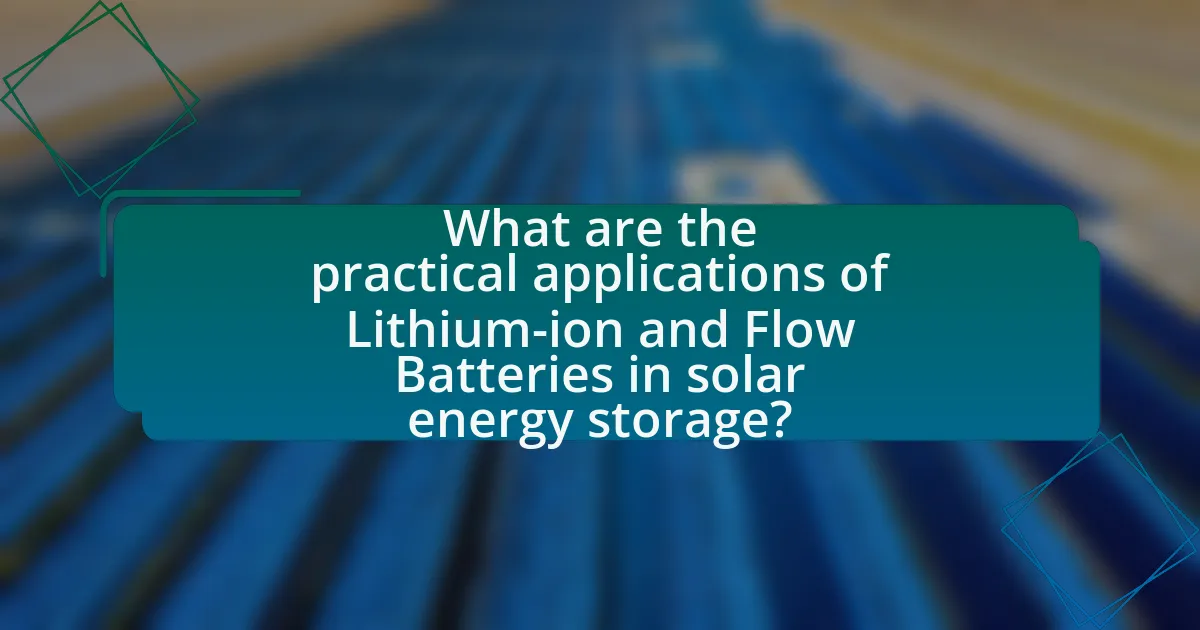

Lithium-ion and Flow Batteries are utilized in solar energy storage for various practical applications, including residential energy storage, grid stabilization, and renewable energy integration. Lithium-ion batteries are commonly used in residential systems due to their high energy density and efficiency, allowing homeowners to store excess solar energy for use during non-sunny periods. Flow batteries, on the other hand, are advantageous for larger-scale applications, such as utility-scale energy storage, because they can provide longer discharge times and are easily scalable. For instance, a study by the National Renewable Energy Laboratory highlights that flow batteries can support grid services like frequency regulation and load shifting, making them suitable for balancing intermittent solar generation.
How are Lithium-ion batteries currently used in solar energy systems?
Lithium-ion batteries are currently used in solar energy systems primarily for energy storage, enabling the capture and utilization of solar power generated during the day for use during periods of low sunlight or high demand. These batteries facilitate grid independence and enhance the efficiency of solar installations by storing excess energy produced, which can then be discharged when needed, thus optimizing energy consumption. According to the U.S. Department of Energy, lithium-ion batteries have become the dominant technology in residential and commercial solar energy storage due to their high energy density, longer lifespan, and decreasing costs, making them a practical choice for integrating renewable energy sources into the grid.
What types of solar energy projects benefit most from Lithium-ion batteries?
Utility-scale solar energy projects benefit most from Lithium-ion batteries. These projects require efficient energy storage solutions to manage the intermittent nature of solar power generation. Lithium-ion batteries provide high energy density, rapid charging and discharging capabilities, and longer cycle life, making them ideal for balancing supply and demand in large-scale solar installations. According to the National Renewable Energy Laboratory, Lithium-ion batteries can enhance grid stability and support renewable energy integration, which is crucial for utility-scale applications.
In what scenarios are Flow batteries preferred for solar energy storage?
Flow batteries are preferred for solar energy storage in scenarios requiring long-duration energy discharge and scalability. These batteries excel in applications where energy needs to be stored for extended periods, such as in renewable energy systems that experience intermittent generation, like solar power. Flow batteries can be easily scaled up by increasing the size of the storage tanks, making them suitable for large-scale solar installations. Additionally, they have a longer cycle life compared to lithium-ion batteries, which is advantageous for projects with frequent charge and discharge cycles. This durability is supported by their ability to maintain performance over thousands of cycles, making them a cost-effective solution for long-term energy storage in solar applications.
What specific advantages do Flow batteries provide in large-scale solar applications?
Flow batteries offer several specific advantages in large-scale solar applications, including scalability, long cycle life, and enhanced safety. Their modular design allows for easy scaling to meet energy storage needs, accommodating varying capacities without significant infrastructure changes. Flow batteries also have a long cycle life, often exceeding 10,000 cycles, which reduces the frequency of replacements and lowers long-term costs. Additionally, they utilize non-flammable electrolytes, making them safer compared to lithium-ion batteries, which can pose fire risks. These characteristics make flow batteries particularly suitable for integrating renewable energy sources like solar power into the grid efficiently and reliably.
What are the best practices for selecting between Lithium-ion and Flow batteries for solar energy storage?
The best practices for selecting between Lithium-ion and Flow batteries for solar energy storage include evaluating energy density, cycle life, cost, and application requirements. Lithium-ion batteries offer high energy density and efficiency, making them suitable for applications with space constraints and where weight is a factor. They typically have a cycle life of 2,000 to 5,000 cycles, which is beneficial for frequent charge and discharge scenarios. In contrast, Flow batteries provide longer cycle life, often exceeding 10,000 cycles, and are ideal for large-scale storage where space is less of a concern and longer discharge times are needed. Cost considerations also play a crucial role; while Lithium-ion batteries have lower upfront costs, Flow batteries may offer better long-term value due to their longevity and lower maintenance needs. Therefore, the selection should be based on specific project requirements, including budget, space, and intended use.
